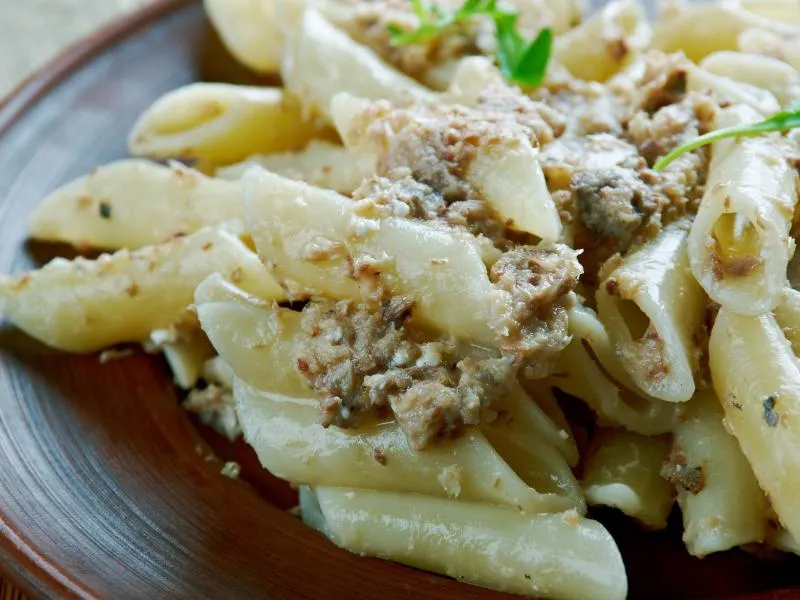Pasta con le Sarde
Fresh sardines and wild fennel with pasta, raisins, pine nuts, and saffron in a Sicilian tradition.
👉 View Authentic Recipe 👈
About This Dish
Pasta con le Sarde is a distinctive Sicilian pasta dish that perfectly exemplifies the island’s complex culinary history, particularly the Arab influence on its cuisine. Originating in Palermo, this dish combines the abundant local seafood of Sicily’s coastline with ingredients introduced by Arab rulers in the 9th century, including raisins, pine nuts, and saffron, creating a uniquely sweet-savory flavor profile not found in other Italian regions.
The hallmark of authentic Pasta con le Sarde is the combination of fresh sardines with wild fennel (finocchietto selvatico), which grows abundantly throughout Sicily and gives the dish its characteristic anise-like flavor. Traditionally, bucatini pasta is used, though spaghetti is also common, and the finished dish is often topped with toasted breadcrumbs (pangrattato) representing the grated cheese that would have been unaffordable to many Sicilians historically.
This dish is closely associated with the Feast of St. Joseph (La Festa di San Giuseppe) celebrated on March 19th, when it appears on many Sicilian tables as part of the feast day celebrations. The combination of sardines (representing the sea) and wild fennel (representing the land) symbolizes abundance in a dish that emerged from the resourcefulness of Sicily’s coastal communities.
🧑🍳 Analyzed by CucinaBot
Why This Dish Works
The genius of Pasta con le Sarde lies in its perfect balance of contrasting elements: the umami-rich oiliness of the sardines is cut by the bright, herbaceous notes of wild fennel, while the sweetness from raisins and slight bitterness from pine nuts create a complex flavor profile. The saffron adds an aromatic quality that ties these seemingly disparate ingredients together. This combination exemplifies the culinary principle of balancing fat (sardines, olive oil) with acid (often lemon or white wine), sweetness (raisins), and herbaceous notes (fennel) to create a fully rounded dish.
Key Success Factors
- Freshness of Sardines: Use only very fresh sardines, identifiable by bright eyes and firm flesh - frozen sardines compromise both flavor and texture
- Proper Fennel Ratio: Wild fennel should be abundant enough to balance the fish (roughly equal parts by volume when cooked)
- Pasta Water Usage: Reserve and use starchy pasta water to help emulsify the sauce
- Thorough Soaking: Soak raisins until fully plump to ensure proper texture and flavor distribution
Common Pitfalls
Many non-authentic versions use excessive tomato, which overwhelms the delicate balance of flavors, or they omit the essential breadcrumb topping. Another common mistake is inadequately cleaning the sardines, which should be completely deboned and filleted to avoid unpleasant small bones in the final dish. Substituting cultivated fennel bulb without adding fennel seeds fails to achieve the intense, herbal character that defines this dish.
How to Judge Authenticity
When reviewing recipes, look for these markers of authenticity:
- Uses fresh sardines, not canned or other fish substitutes
- Includes wild fennel fronds (or a combination of fennel bulb and seeds as a substitute)
- Contains the sweet-savory combination of raisins and pine nuts
- Includes saffron for color and aroma
- Tops the dish with toasted breadcrumbs rather than cheese